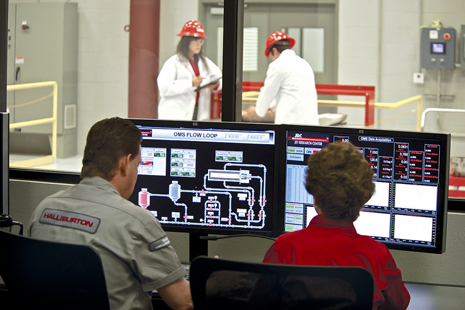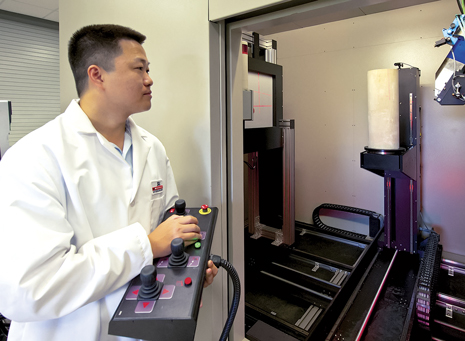Innovative thinkers
Halliburton’s Jet Research Center: Testing perforating flow for extreme environments
|
Halliburton’s Jet Testing perforating flow for extreme environments
Ten years ago, the idea of drilling wells at 30,000 psi and 300°F seemed near impossible, and the idea of being able to replicate harsh HPHT conditions seemed less plausible. Today, thanks to advancements in both the oil and gas, and medical industries, both are a reality. From 50,000-psi test vessels to the oil and gas industry’s first use of a computed tomography (CT) scanner, all in one laboratory the Advanced Perforating Flow Laboratory at Halliburton’s Jet Research Center (JRC) gives engineers a chance to emulate some of the most extreme downhole conditions—all from the click of a button. Located on over 800 acres in Alvarado, Texas, JRC was originally established as a research, testing and manufacturing facility for oil and gas explosive products. “The original flow lab has been operating for 12 years, and we have conducted more than 650 tests for our customers… Today, approximately 200 employees support the work performed at the JRC,” said Daniel Dorffer, Strategic Business manager - Integrated Cased Hole, Wireline and Perforating. Typically, the only way to predict how a well will respond to being perforated in real-life conditions is to test a perforator gun in a cement block with casing equipment at surface conditions. While one may be able to supply some data on how the perforation might perform in real life, to really understand how a well will respond in today’s extreme downhole conditions, it is necessary to test the process in as close an environment as that in which it will be used out in the field. “We recognized the need for a step-change in technology because of the new, challenging environments in which we were operating, such as high-pressure/high temperature. We decided that we could better help our customers develop their perforating solutions, and improve recovery, by replicating these downhole environments as much as possible,” said David Topping, V.P., Wireline and Perforating. “Through the use of imaging technologies, we are able to examine the target to better understand the interaction of a perforating event with the reservoir. This allows better prediction of the production results that can be expected.” As part of this unique process, JRC either receives samples from customers that were taken as part of core sampling, or, if not available, uses an outcrop rock sample chosen based on closest matching porosity, permeability and unconfined compressive strength (UCS). “JRC has access to quarried rocks, such as Carbon Tan ( low-permeability, medium-porosity rocks with moderate UCS, commonly representative of gas-bearing formations), Castlegate sandstone (high-permeability, low UCS rocks, where sanding is an issue) and conventional Berea sandstone (typically a moderate-to-high porosity and permeability rock with high, unconfined compressive strength representative of oil-bearing reservoirs), which have historically been close to applications in common clastic reservoirs,” said Dorffer. While this makes the samples, themselves, as close to the downhole geologic formation as possible, it is the conditions under which JRC is able to test the perforator gun and then analyze the sample that give engineers a peek at what will happen out in the field. Since the most extreme wellbores face pressures of 25,000 psi and temperatures of 300°F, JRC has a range of three testing vessels, all of which emulate a real downhole HPHT environment. The center has two 25,000-psi vessels that are able to test a perforation, or fracturing operation. One of the vessels has temperature capability to 400°F temperatures. To simulate the effects on a horizontal well, the other vessels rotates 180°, adding the effect of gravity into the test. With the quick pace of advancement in the industry, JRC recently added a 50,000-psi vessel—the first of its kind in the industry. After the tests are performed, engineers are able to analyze the samples, based on dozens of different characteristics, to evaluate reservoir and wellbore response, wellbore and pore pressure, and overburden stress. To fully understand the effect of the perforation or frac from the inside out, JRC engineers decided to turn to the medical field, to see how advanced imaging technology could be applied to perforating studies. The team decided to employ a CT scanner—and became the first in the industry to have it in one consolidated facility. The industrial, non-destructive-testing class scanner does not require room-wall shielding, so the sample can be placed on a lead brick, walled cabinet, on a turnstile for continuous multiple-slice, X-ray imaging at specific angle increments. Ultra-high-speed processors reconstruct thousands of slice images to create a high-resolution 3D image. “The use of a CT scanner has proven to be effective in conventional core analysis for many years. In our case, the CT scanner allows a vivid 3D view of the core, but also of the perforation tunnel. Without a CT scanner, core samples are split in half to measure penetration depth and perforation tunnel geometry in only a 2D plane,” said James Barker, Technology manager-Research, Testing & Regulatory, Halliburton Jet Research Center. “The ever-growing list of ancillary uses enabled by the in-situ scanner include the visualization of the volume and location of liner material/perforating debris in the perforation tunnel, the relative density of material in the perforation tunnel, and fluid flow paths into the perforation tunnel while controlling confining stress.” The JRC is the first facility anywhere in the world to earn all certifications simultaneously: the ISO 9001 (a standard of quality), ISO 14001 (environmental care), OHSAS 18001 (health and safety) and the ACC/ISO RC 14001 (responsible care). The certifications were awarded by the Quality Management Institute (QMI), the largest third-party register and industry leader in certification of management systems. QMI also stated that the Six Star QHSE Management System is the first known management system to successfully integrate all standards under one management system, making it possible to certify to all standards during one integrated audit. In addition to the Trilogy and Responsible Care certifications, JRC has also obtained the OSHA Voluntary Protection Program STAR status. While the JRC team is excited about its new high-pressure test vessels, it continues to look ahead at where the industry is headed next. “After all the test responses and downhole data transferability are fully understood, the next step is to explore ways to use the APFL to improve well completions in any further way possible,” said Barker.
|
- Prices and governmental policies combine to stymie Canadian upstream growth (February 2024)
- U.S. producing gas wells increase despite low prices (February 2024)
- U.S. drilling: More of the same expected (February 2024)
- U.S. oil and natural gas production hits record highs (February 2024)
- U.S. upstream muddles along, with an eye toward 2024 (September 2023)
- Canada's upstream soldiers on despite governmental interference (September 2023)
- Applying ultra-deep LWD resistivity technology successfully in a SAGD operation (May 2019)
- Adoption of wireless intelligent completions advances (May 2019)
- Majors double down as takeaway crunch eases (April 2019)
- What’s new in well logging and formation evaluation (April 2019)
- Qualification of a 20,000-psi subsea BOP: A collaborative approach (February 2019)
- ConocoPhillips’ Greg Leveille sees rapid trajectory of technical advancement continuing (February 2019)





